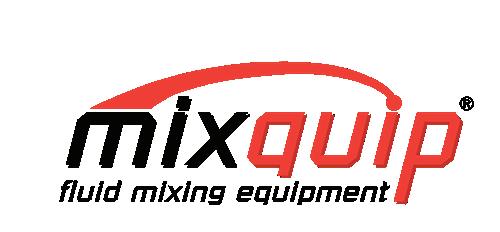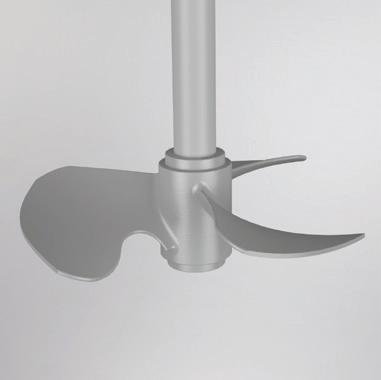







Edition 4 of Mixquip’s mixPRO is focused to explore the impeller options and how each different impeller is designed to suit each individual mixing requirement. Science of impellers and understanding the basics of viscosity and agitation is important in every mixing process. Your Process Matters and that’s why in this edition we look at some applications and explore impellers designed and fabricated by Mixquip in Australia taking into account all critical factors of mixing and agitation.
With a focus on Mixquip’s latest innovation in impeller technology, Toro-Jet, we’ll explain the concept of slow agitation but fast consistent results and open up how this impeller is best-suited to many and varied mixing applications. We hope you enjoy this edition and look forward to speaking soon! For more information on our mixer range and mixing solutions visit the Mixquip site at www.mixquip. com, purchase online or speak to an engineer to get access to our extensive knowledge and industry experience applications. Call us today on +61 (02) 4629 3050 for your mixing needs.

A wide range of impellers are used in a huge variety of mixing applications. The design and dimensioning of the impellers, selection of a suitable mixing system and the layout of the individual components have a decisive influence on the process and mechanical properties. Comprehensive optimisation of conventional impellers for specific industry sectors is the reason behind the development and continual development of Mixquip’s range of impellers.
Impellers can be classified according to the following features:
• Primary flow direction
• Wall clearance
• Tip speed
• Viscosity range
• Flow regime

Learn about viscosity in mixing applications.

Impellers are usually classified according to the primary flow direction, however a lot of factors are to be considered when selecting the right impeller.




Flow within mixing can vary dependant on the solution type. There are four different flow types that can be achieved in a certain volume of fluid; Axial, Radial, Tangential and High-Shear. Flow is described in the terms of the intensity it creates, measured by comparing fluctuating velocity against the mean velocity. Different mixing impellers are suited to the corresponding materials in which will be mixed. Having a solid understanding of your solution type is important to ensure the correct impeller is chosen to achieve the desired results. This is where Mixquip helps you, because to us, “Your Process Matters’’
Axial flow impellers are used with low viscosity media and are excellent for blending and suspension duties. The flow pattern has a strong axial suction and bundled discharge stream in the turbulent flow range. The outlet jet stream is deflected at the bottom and reaches the surface in the wall area of the vessel. The liquid is accelerated in the propellor

Radial flow impellers are used with a range of viscosity media and are excellent for gas liquid mixing and dispersion duties. The flow pattern is ideal for low level mixing. The liquid is accelerated via centripetal force outwards of the propellor zone until meeting the tank wall where flow is directed both upward and down to create effective mix patterns and movement. Multiple impellers required for tank geometries greater

Mixquip Gate style impellers are typically used with highly viscous materials and in the laminar flow range to disrupt the boundary layer adhering the vessel walls where heat transfer is required in both heating/cooling applications. Fingers or frames can be added to increase versatility of these impellers or combined with axial/radial blades as a

Combined flow impellers use both axial and radial liquid movement and are suitable for use with non-Newtonian fluids covering a wider range of apparent viscosities. The impellers create strong fluid flow patterns which are deflected at both the wall and the bottom of the tank. This combined flow action is ideal for mixing in the transitional and laminar





Mixquip Toro-Jet has been designed to combine both axial and radial mixing regimes. The impeller design means that is able to produce a flow pattern without deadzones throughout the entire vessel. Ideally suited to mixing non-Newtonian fluids, this impeller covers a wide range of consistency and flow behaviour characteristics. Toro-Jet impeller design is based around the technique of slow agitation but fast results.

STAGE ONE

STAGE TWO

STAGE THREE

TORO-JET WITH CLOSED CONES

• Low to medium viscosity fluids
• Applications such as Food & Beverage, paint, varnish, chemicals and cosmetics
TORO-JET WITH OPEN CONES

• High & extreme viscosity fluids
• Applications such as Wall plasters, glues and sealing compounds.
Designed to suit most IBC containers with it’s heavy-duty form and robust construction, the Series 200 Rummager is ideal for demanding mixer applications. In package with the Mixquip Toro-Jet impeller, this creates the perfect solutions for a variety of applications such as blending, dispersing and suspending viscous liquids and high solid slurries or wetting and dissolving powders. A cost-effective and time saving mixing system best suited to the widest range of mixing requirements.
The Jan - Mar 2022 mixing package. Enquire today on 1300


mixquip@teralba.com
Client Focus:
Food Manufacturer - Dairy Products


“This video shows how our customer uses the Mixquip Series 200 IBC mixer, equipped with the unique Toro-Jet folding impeller, to pre-mix cream for inclusion in a dairy product. The IBC with cream can be removed from cold storage, mixed and used directly into the product. There is no need to double handle and dispense in a separate mix tank. Removes one step in the production process, minimizes manual handling and contamination risks.”
Blend, disperse, suspend. The Toro-Jet impeller system can cover a wide range of mixing applications without the need for fitting different impellers.
The unique design of the Toro-Jet impeller means that it can be located close to the base of the mixing container. This ensures that the powerful axial suction created by the impeller doesn’t draw air into any vortex created by the liquid movement.
Mixquip has developed the Toro-Jet, suited for a wide range of viscosities which greatly reduces downtime and in turn increases efficiency. This unique feature is due to the geometrical shape of the mixing elements.

APPLICATIONS:
» Cream
» Specialty chemicals
» Oil blending
» Solid resin for varnish
» Paint & Laquer Manufacture
» Fertiliser Production
» Shampoos & Cosmetics
» Sauces & preserves
» Pharmaceuticals
*these applications are not limited, please speak to us if you have a specific application.
The torodial flow at the mix head forces product through the mixing elements. The resultant axial and radial flow increases the efficiency of mixing times and consistency of product.
Optimum mixing can be achieved in a very short time, even at the lowest circumferential speeds, strength lying in the special geometry of the conical mixing elements, with skillfully engineered spatial and angular relationships.
Short mixing times and low motor power requirements for maximum cost-effectiveness.
Mixquip Toro-Jet impeller design has a low power number than other impeller systems resulting in more liquid movement with less energy consumed.

“ Very very impressed with the mixing action. With the old mixer we had to beat the garlic for 20 minutes and basically turn it into toothpaste. The Toro-Jet is slow speed but thorough mixing and we can use the product within 1 minute. Literally! Amazing mixing action. Very impressed. “



Your Process Matters. At Mixquip we understand that technical mixing challenges in todays process industry are frequently associated with optimising already highly developed equipment. Standard impellers are no longer able to meet the demand and challenges in many modern applications and special types of agitators or mixing systems are often required to fulfil the diverse range of mixing tasks under the respective process conditions.
With our intellectual assets working for you, Mixquip has been adapting to solve most mixing challenges, over the past 40 years, by integrating the combined experience in process, mixing and impeller deign with technology to deliver scientiftic knowhow required for your process.

• Low viscosity fluids
• Suited to high shaft speeds
• Suitable for blending solid/liquid and liquid/liquid

• High intensity mixing
• Gas dispersion and solids suspension
• Low flooding limit coupled with high powder numbers

• Low to high viscosity mixing applications
• Ideally suited to mixing non-Newtonian fluids
• Covers a wide range of consistency and flow behaviour characteristics

• Low to medium viscosity fluids
• Axial flow
• Suitable for breaking agglomerates and distributing solids.

• Positive mixing in laminar, high viscosity regimes
• Very versatile
• Adjustable blade angle and ratio between tank and impeller diameters

• Highly viscous materials
• Laminar flow range to disrupt the boundary layer
• Can be combined with other axial or radial blades
• Custom designed to suit tank size

• High shear mixing
• Fine grinding of solids and disperse of pigments
• Varying blade configurations

• Low viscosity fluids
• Adjustable blade angle and ratio between tank and impeller diameters
• Axial flow
The Mixquip impeller design range covers almost every mixing application requirement. Maximum product yield, consistency, superior batch quality, smooth dependable operation and guaranteed process results are all hallmarks of Mixquip.


